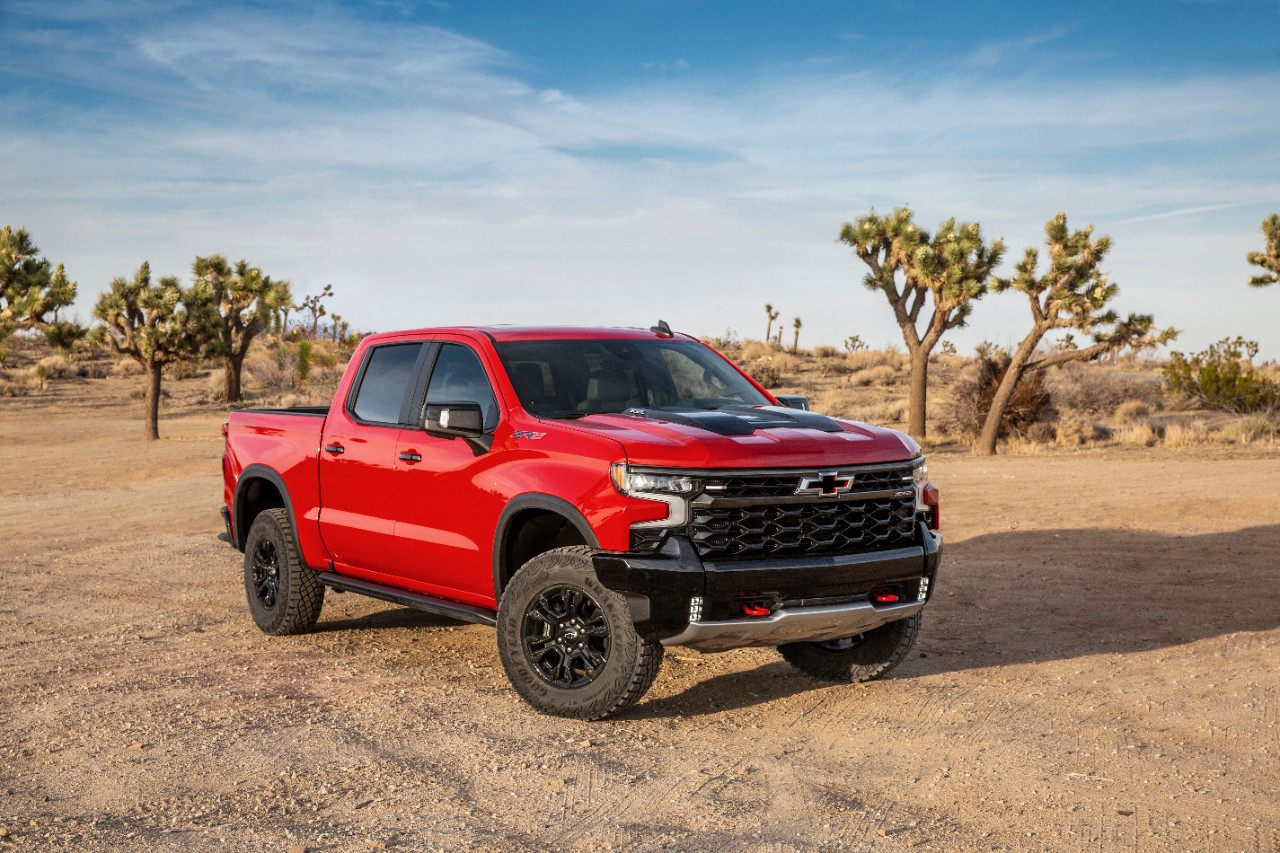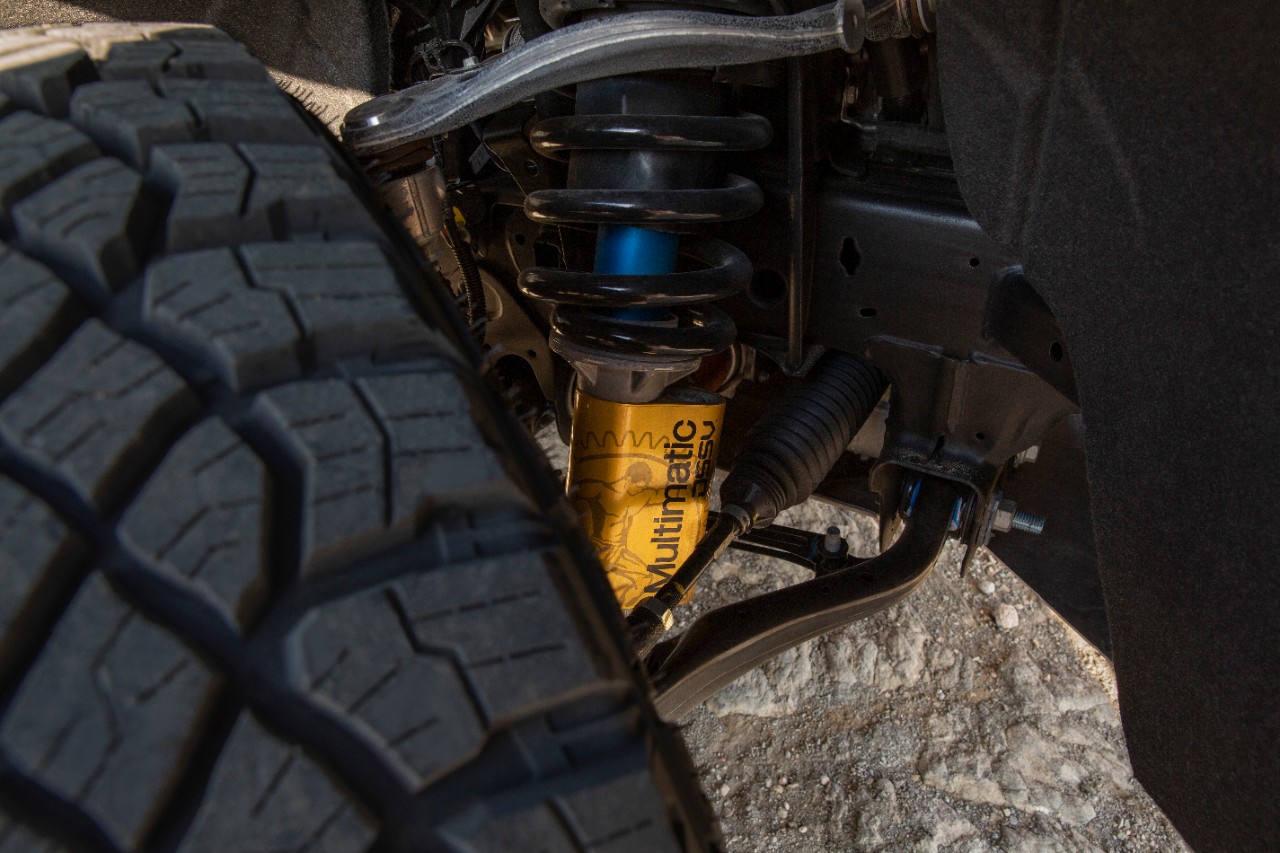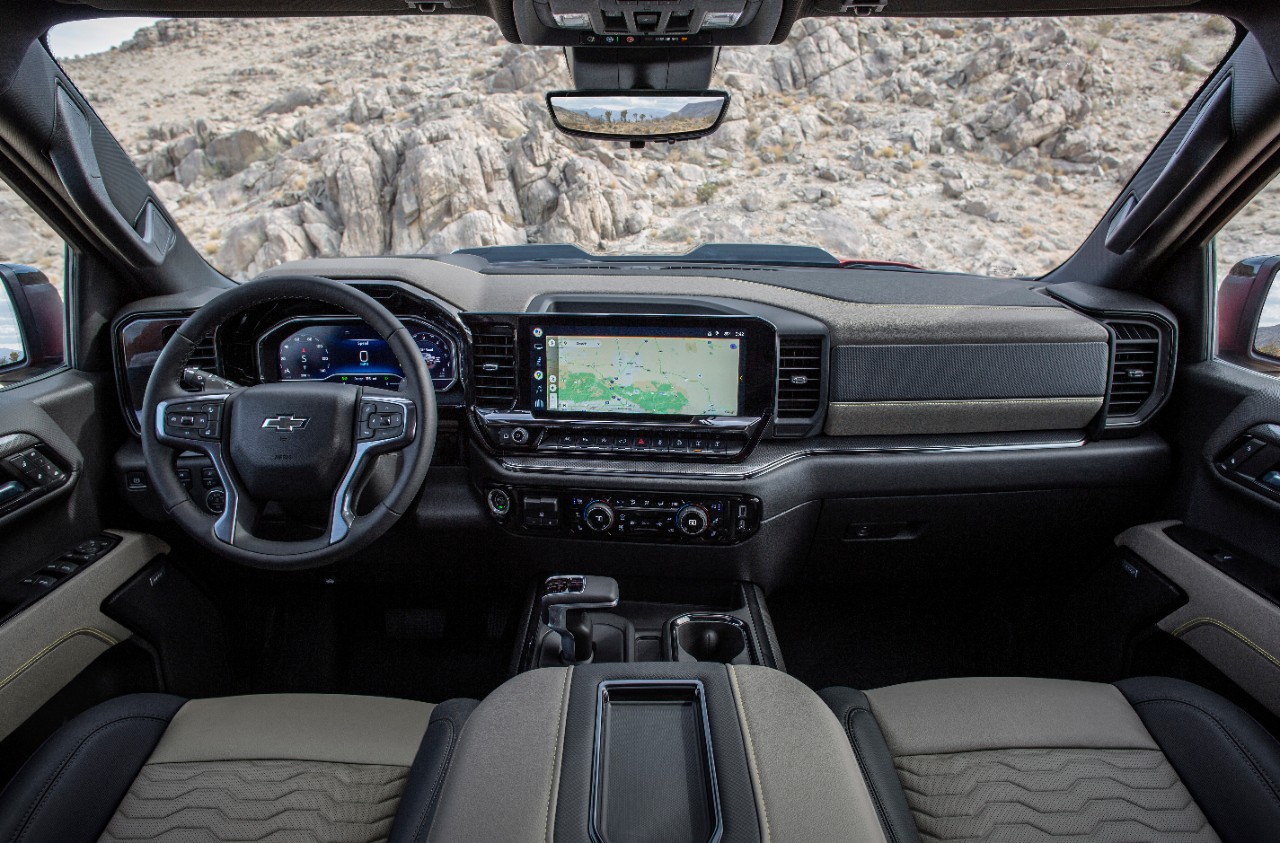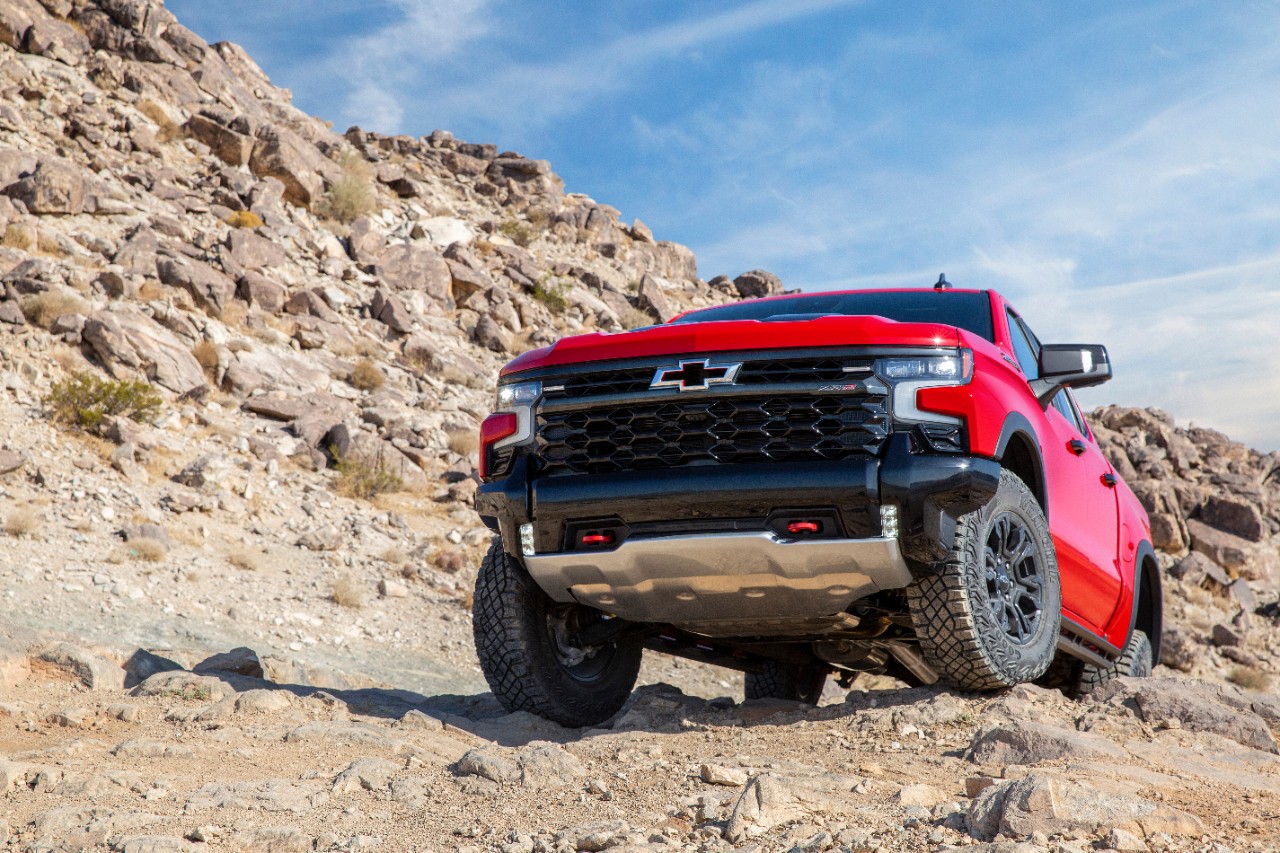“Chevrolet raises the bar with the most capable half-ton, full-size truck ever sold in North America.”
Change can come from the most unexpected of places, the passion and commitment of a few individuals shifting the course of an organization. We witnessed that in the early 2000s with the Jeep team launching the Rubicon, and now again with the GM team redefining pickup capability with the ZR2 lineup of Colorado and Sierra. The off-road group kept pushing, communicating to management the wild success of the Bison, and the AT4 lineup at GMC. How far could they press capability? Far enough to yield the most capable GM trucks ever produced, and arguably the most capable half-ton pickup ever sold in North America.

For 2022, Chevrolet is upsizing the ZR2 Colorado to the Silverado 1500 with an exhaustive list of new trail hardware.
ZR2 Overland and Off-Road Hardware Highlights:
- Aluminum front skid plate
- GVWR front tow hooks
- Increased approach angle to 32 degrees, including relieved steel bumper corners
- 33” Goodyear Hybrid AT/MT noise canceling tires
- Front Eaton driver selectable e-locking differential
- Significantly upgraded CV axles with added strength and travel
- Multimatic DSSV reservoir front coil-over with 40mm more suspension compression travel
- One pedal speed control in Terrain Mode (accelerate and brakes using only the throttle)
- Full-size Transfer Case skid plate
- Available rocker panel protection (rated to 50% GVWR)
- Off-road mode opens up yaw and VSC thresholds for higher speed dirt roads
- Rear Multimatic DSSV dampers with custom tuned springs
- Rear driver selectable e-locking differential
- Steel rear bumper with high-clearance exhaust
- 8 cameras to assist with navigating tight terrain
- onX and Gaia GPS displays on the 13.4” screen

Technical Terrain Performance
Locking differentials are always praised for their improvements to tractive performance, but on a full-size truck like the Silverado, lockers help slow everything down. The driver can navigate terrain at a much slower speed, aided by a spotter to help reduce the change of body damage or getting stuck. The previous generation Silverado off-road models relied on the all-mechanical G80 locker, which required considerable wheel spin to engage, and was only available on the rear. There was also the unpredictable nature of how the G80 would affect the vehicle’s position, often sliding the truck off of the desired line.


With the driver-selectable lockers of the new ZR2, it allows the operator to move through rocks or cross-axle climbs at a much slower speed, reducing wheel spin (which damages the trail) and helping to control suspension compression (which reduces ground clearance). On a long-wheelbase (148 inches) like the Silverado, a front locker is rarely needed for most climbs, but it can greatly assist once the climb includes ledges, large rocks, and deep holes.
We experienced that on our way through Berdue Canyon outside of Joshua Tree National Park. There was a steep, loose, and cross-axle climb that would test the capability of any stock vehicle. The holes were deep enough to easily lift a tire, or even make contact to the body on the average 4WD. Facing the climb, I locked the front and rear differentials, and engaged off-road mode. Preferring left foot braking, I eschewed terrain mode, preferring to manage throttle and brake modulation as a luddite. The Chevy is wide and stable, with impressive articulation from the rear axle and sufficient ground clearance at every corner.
The 6.2 liter V8 rumbled forward, effortlessly turning the 33 inch tires with the available 460 lb.-ft. of torque and 43:1 crawl ratio. While the locking differentials did most of the work, the 275/70 R18 Goodyear Territory MT tires also impressed, combining a hybrid AT/MT tread pattern, with a scalloped sidewall and generous siping. These tires are not only excellent in dry rock and sand desert conditions, they are also impossibly quiet on the highway. The suspension articulation is good for an IFS vehicle, particularly in the rear, where the longer stroke of the Multimatic dampers allowed for maximum droop. This kept the tires in contact with the climb for all but the deepest holes, while also not exhibiting any unexpected weight transfer or pop during the ascent. In a word, the climb was effortless.
Additional traction tests included steep, shale climbs, interspersed with loose gravel and rocks. The only limitation is the size of the vehicle, resulting in a few rock scrapes on the sliders or desert pinstriping from other members of the group. Head toss was minimal, which was surprising given the firm rate of the front sway bar. Passenger comfort was no-doubt enhanced by the DSSV shocks and compliance in the aired down Goodyears. In an industry awash with go-fast desert packages, the ZR2 has a refreshing focus on overall trail capability. It is narrower, and more tractable than the long-travel offerings, while still benefiting from the higher-speed capabilities of the Multimatic shocks.
As an Overlander
Overlanding often includes a lot of travel miles, with hours spent traversing both pavement and dirt roads. We need our overland vehicle to perform well in technical terrain, but also while laying down the miles en route to our destination. For this, the ZR2 is a comfortable cruiser, being surprisingly quiet, yet also composed at speed. The Multimatic shocks that work well in the dirt also help to ensure the Silverado is composed on the pavement. When we test vehicles, we expect them to perform equally well in both situations.
The seats are supportive and comfortable, including both heating and cooling to reduce driver fatigue. The electronics package is also robust, with a full complement of connectivity, charging, and cameras to assist the driver. Radar cruise control and lane assist is also available, helping to keep progress efficient and safe. The 6.2 liter is certainly powerful, but that also comes at a cost to efficiency, with the range barely achieving 300 miles in most conditions. As is demonstrated with ¾ ton and 1 ton trucks, it is the marriage of trucks and diesel powerplants that always win the day. Fortunately, Chevrolet has one of the best small-displacement turbo diesels ever made in the 3.0 Duramax, mated to the 10-speed automatic. We will all hold our collective breaths for that power train to be available in the ZR2, and give us 20+ miles per gallon out of a double-locked dreamlander.

At speed in the dirt is confidence inspring, with the Multimatic suspension soaking up events like a champ. This is due in part to the additional compression travel, but primarily because of the DSSV dampers. With added fluid volume, these shocks did not overheat, even after spirited runs across the Mojave Desert. I was able to rest my hand on the shock after a 15+ mile burn in heavily corrugated terrain- It was warm, but not hot. And even if the shocks do get hot, the spool valve technology actually thrives on changes in viscosity and even turbulent fluid conditions. As a result, these shocks will not fade like most shocks, and are exactly the same units used by the Chevy Baja race team.
Some final notes on dirt roads should include mode selection, and an understanding of what “off-road” mode actually means in a GM 4WD. Most manufacturers have some version of a multi-terrain selector, but what “off-road” means on the ZR2 is actually closer to sand mode in other makes. “off-road” changes the algorithms for vehicle yaw, main shaft angle, wheel spin, brake traction control, and ABS. The mode loosens all of these thresholds up, allowing for more rotation (i.e. oversteer), less traction control, and less throttle intervention. Use “off-road” in the sand, and at speed when in the fun zone. It can still be used at low speed, but the operator should engage the front and rear lockers as required to control wheel spin. Terrain mode on the other hand tightens the brake traction control thresholds, and permits one foot vehicle control.
Conclusions
Full-size trucks continue to gain popularity for overland travel, and for good reason. They are often more comfortable and durable than mid-sized offering, and they typically allow for the installation of a large/comfortable camper in the bed. With the launch of the new ZR2 Silverado, class-leading capability is now an attribute to add to the list. However, it is not without a few notable compromises, the sub-1,400 pound payload being one, and the fuel economy of the 6.2 liter V8 being the other (I averaged barely 11 mpg for the test loop). Admittedly, I do have a bias for the 3.0 liter diesel, with it being the engine in my AT4, and my preference for having the added range in the backcountry. With a 1,600-1,800 pound+ payload, and the 3.0 liter turbo diesel, this new ZR2 will truly be the ultimate half-ton overlander. What an incredible journey the GM truck team has undertaken, launching the Colorado Bison, then the Hummer Supertruck, and now the ZR2 Silverado- we cannot wait to see what they come up with next.
With a 1,600-1,800 pound+ payload, and the 3.0 liter turbo diesel, this new ZR2 will truly be the ultimate half-ton overlander. What an incredible journey the GM truck team has undertaken, launching the Colorado Bison, then the Hummer Supertruck, and now the ZR2 Silverado- we cannot wait to see what they come up with next.
Pros
Multimatic DSSV
Front and Rear Lockers
Optimal combination of comfort, capability, and utility in a half ton
Cons
No diesel (yet)
No rear locker in 4WD at higher speeds
Payload of less than 1,400 pounds
Knee hits 4wd switch (which will likely lead to damage)


